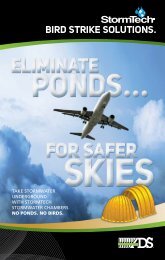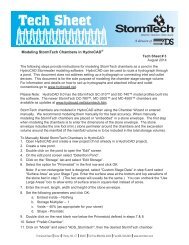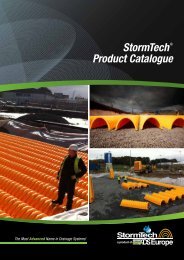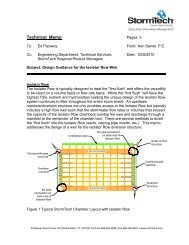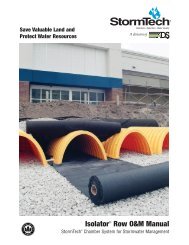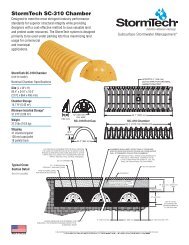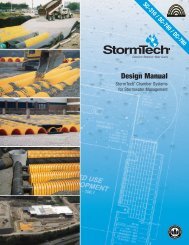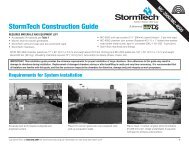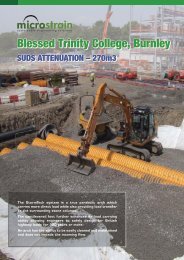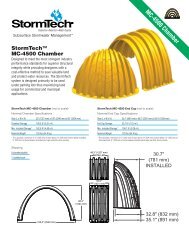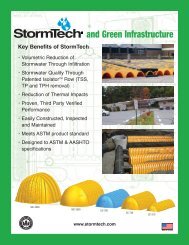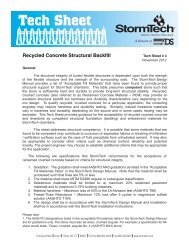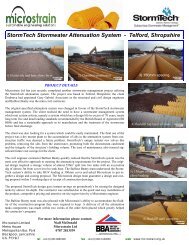Tech Sheet 2 - StormTech
Tech Sheet 2 - StormTech
Tech Sheet 2 - StormTech
You also want an ePaper? Increase the reach of your titles
YUMPU automatically turns print PDFs into web optimized ePapers that Google loves.
Geotextile Materials:<br />
6-ounce AASHTO M288 Class 2 non-woven separation geotextile<br />
over the top of stone (ADS 601 or equal)<br />
8-ounce AASHTO M288 Class 2 non-woven geotextile<br />
for use as protection layer for PVC, RPP and LLDPE (ADS 801 or equal)<br />
Page 3 of 6<br />
<strong>Tech</strong> <strong>Sheet</strong> #2<br />
12-ounce AREMA Chapter 1 Part 10 Category “Regular” non-woven geotextile<br />
for use as protection layer for LLDPE and other PE membranes (ADS 1201 or equal)<br />
Seaming Options:<br />
1. Prefabricated vs. Field Prefabricated seams are preferable to field seams for all liner materials<br />
whenever possible.<br />
2. Solvent Welded PVC only, low cost<br />
3. Heat Welded Costly, require trained seamer, for all liner materials<br />
4. Taped Cost effective, M50-RC Gray distributed by Titus Industrial Group recommended, single<br />
sided, 4” width, for all liner materials. No water tightness data is available.<br />
5. Overlapped Not water tight, no leakage rates available, suggest 4 ft overlap for all materials.<br />
Pipe “boots” are used to seal pipe penetrations through the liner. Boots can either be prefabricated by<br />
the liner fabricator or field fabricated by the contractor. The boot is then solvent cemented, heat welded<br />
or taped to the liner. A pipe clamp is normally used to seal the boot around the pipe. Seaming and<br />
sealing pipe boots at low temperatures (32° F minimum) requires preheating of the material.<br />
Design:<br />
General The design of a lined system must be performed by the consulting engineer and, at minimum,<br />
requires knowledge of design storage, peak flow rates and maximum seasonal high groundwater<br />
elevation. This information is used to design the peak flow control structure, maximum liner height and<br />
groundwater control (if necessary).<br />
High Flow Bypass A high flow control is an important component for any lined system. The high flow<br />
control is designed to pass the peak flow while ensuring that the liner is not overtopped. The control<br />
structure can be an upstream high flow bypass or a downstream overflow structure. In both cases, a high<br />
flow weir, very similar to the high flow control in a pond outlet control structure, is normally used. The high<br />
flow weir should be sized such that the water surface elevation based on the maximum head on the weir<br />
is less than the top of the liner. Additional freeboard should be provided.<br />
In a typical upstream bypass design, the calculated depth of flow over the weir (H) is subtracted from the<br />
maximum water surface elevation in the chamber system to establish the weir crest elevation. The storage<br />
in the chamber system associated with the weir crest elevation may be a design constraint. The designer<br />
may choose to increase the weir length and therefore decrease the flow depth to establish a higher weir<br />
crest.



